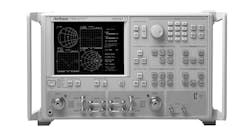This file type includes high-resolution graphics and schematics when applicable.
Fifth-generation (5G) networks are expected to require wider bandwidths and higher frequencies. As a result, characterizing power amplifiers (PAs) and other components will become even more complicated. To measure these devices, a wide-bandwidth vector network analyzer (VNA) measurement approach can be utilized. In the white paper, “Millimeter-wave VNA characterization using modulated signals,” Anritsu discusses how a VNA-based measurement platform can benefit higher-frequency PA measurements for 5G and related applications.
Characterizing PAs for future 5G applications will be extremely vital. However, accomplishing this will be more challenging for a number of reasons. For example, measurement stability and repeatability can be more difficult as a result of higher carrier frequencies. And wider bandwidths and higher frequencies tend to mean lower return losses, which can affect measurement accuracy. The white paper discusses other challenges, as well as PA parameters that play an important role when it comes to wider bandwidths. A wide-intermediate-frequency (wide-IF) VNA platform is one approach to solving these challenges, as it has intrinsic match characterization and correction capabilities. Its inherent capability to ratio helps with stability and accurate power delivery. In addition, the VNA’s normal low-level sweep capabilities can help with measurement speed.
The white paper discusses a measurement setup based on the MS464XB VNA equipped with several options. Modulated signals can be generated by using an external modulated source alongside the VNA. By using either the internal VNA source or an external synthesizer as a local oscillator (LO), the output of the external source is then upconverted to the desired frequency. The document also discusses calibration, which can significantly impact measurement accuracy.
Several example measurements and scenarios are demonstrated. The first example presents output power measurements of an amplifier supplied with a 60-MHz bandwidth signal. Measurements were performed with both a VNA match correction and a normalization calibration. Another example demonstrated phase-deviation measurements for a 60-GHz amplifier with both VNA and normalization calibration. AM/AM and AM/PM measurements of an amplifier at 40-GHz are also presented for both continuous-wave (CW) and modulated waveforms.
Anritsu Corp., 490 Jarvis Dr., Morgan Hill, CA 95037-2809; (408) 778-2000; www.anritsu.com
Looking for parts? Go to SourceESB.

